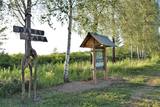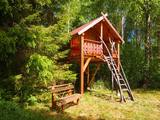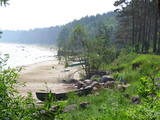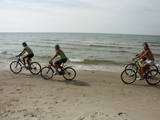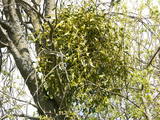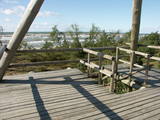| Nr | Name | Beschreibung |
|---|---|---|
|
Kokneses dabas taka (5,65 km) ved gar Daugavas un Pērses krastiem un savieno Kokneses parku un Likteņdārzu. Pastaigā pa dabas taku var doties no jebkuras sevis izvēlētas vietas, kas vijas cauri Kokneses parkam. Takā izveidotas laipas, tiltiņi, informācijas stendi un norādes. |
||
|
Interesantā būve, kurai Baltijas valstīs grūti atrast līdzinieku, ir meklējama 2 km ziemeļaustrumos no Kirblas (Kirbla). 307,8 m garo arkveida tiltu pāri Kazari upei (Kasari jõgi) uzcēla 1904. g. deviņu mēnešu laikā. Tajā brīdī to uzskatīja par Eiropas garāko šāda tipa dzelzsbetona tiltu. Tagad to var šķērsot tikai ar kājām vai ar divriteni. Tumšajā diennakts laikā tilts ir skaisti izgaismots! Tā ievērojamais garums ir skaidrojams ar apstākli, ka pavasara palos Kazari palienes applūst lielās platībā. |
||
|
This farm welcomes groups and individual travellers for a smoke sauna, lunch, and a chance to taste Suiti bread, buns and special seed pastries that are based on ancient recipes. |
||
|
The potter offers tours of his workshop, a chance to use the potter’s wheel to produce your own clay dishes, opportunities to draw, and a chance to manufacture drums and dolls. You can buy the finished products and listen to the craftsman playing his drums. |
||
|
Duke Jacob of the Duchy of Kurzeme and Zemgale was on the throne from 1642 until 1862, and during that time the duchy rapidly expanded ship building operations, opened the first factories and improved agricultural output. Jacob's ships plied the seas to export goods, to establish colonies in Tobago and Gambia, and to bring sugar, coffee and spices back to Europe. This was the age when potatoes first appeared in Latvia, though it took a couple of centuries for them become beloved. |
||
|
Der Hausherr ist Saunameister, Masseur, Kräuterkundiger und Reiki-Meister, interessiert sich für Ethnokultur und bietet den Gästen von den Vorfahren getestete und überlieferte Erholung und Gesundheitsvorsorge in der Sauna, Saunakurse, Geheimnisse der Kräuter, Wiederherstellung der Bande zur Natur, Wasservergnügungen. |
||
|
Этот маршрут предлагает вам отличную возможность посетить самый большой остров Эстонии – Сааремаа, который является своеобразным символом для туризма по Эстонии. На острове находятся один из наиболее впечатляющих метеоритных кратеров в Северной Европе, Епископский замок Курессааре, самая крутая отвесная скала в Эстонии и множество других интересных туристических объектов. |
||
|
Stolz des bäuerlichen Betriebs sind ~ 100 Ziegen, von deren Milch Käse, Quark und Joghurt hergestellt wird. Exkursion zum Hof, Anschauen der Tiere, Verkostung und Erwerb der gesunden BIO-Produkte. In einem nahegelegenen Teich kann man angeln. Die gefangenen Fische kann jeder selber grillen. |
||
|
Zum ersten Mal ist der Name von Kandava in den schriftlichen Quellen im Jahr 1230 erwähnt worden. Im Jahr 1253 hat der Livländische Orden auf dem steilen Ufer des Urstromtales des Flusses Abava eine gemauerte Burg gebaut, an deren Fuß sich eine Siedlung herausgebildet hat. Im 17. Jh. wurde Kandava zu einem bedeutenden Handelszentrum. Die Stadt und ihre Einwohner haben schwer unter der Pest und den Ereignissen des Ersten Weltkriegs gelitten. Die Stadtrechte hat Kandava im Jahr 1917 erlangt. Während der Sowjetzeit wurde der Sportkomplex der Landwirtschaftlichen Fachschule von Jaunkandava zu einem bekannten Ort für Training. |
||
|
Das Schloss von Lielstraupe (deutsch Groß-Roop) ist das einzige erhaltene Gebäude in Lettland, das eine mittelalterliche Burg mit einer Kirche in sich verbindet. Mit dem Bau des Schlosses wurde im Jahr 1263 begonnen. Die Bebauung hat im 17. und 18. Jh., sowie in den Bauernaufständen von 1905 wesentlich gelitten. Der Gebäudekomplex wurde im Jahr 1909 laut den Plänen des Architekten Wilhelm Bockslaff erneuert. In der Kirche von Lielstraupe befinden sich mehrere Kunstdenkmäler, z.B. Malereien eines Orgelchors aus dem 17. Jh. und einer Kanzel aus dem 18. Jh. Im Jahr 1944 wurden in der Kirche die von dem Künstler Sigismunds Vidbergs geschaffenen Glasgemälde Golgatha und Geburt Christi aufgestellt. Auf dem Schlossturm kann man eine Uhr sehen, die der einheimische Uhrmacher Aide gemacht hat, aber auf der Kirchenwand – eine Sonnenuhr besichtigen. Im Schlosspark muss man den im Jahr 1744 aus Holz gebauten Glockenturm besichtigen. Im Jahr 1938 wurde in der Kirche eine Gedenktafel an die im Ersten Weltkrieg und in den Freiheitskämpfen Gefallenen enthüllt. Seit 1963 befindet sich in dem Schloss ein Krankenhaus für Narkologie. Die Kirche kann man während der Gottesdienste, aber die anderen Gebäude nur von außen besichtigen. |
||
|
In Roja kann man sowohl einen Sandstrand mit eingerichteter Infrastruktur als auch die Steinküste finden. An der Steinküste befindet sich ein Seegeröll von Roja – etwa 2m hoch und 12,5 m im Umfang. Für die Meeresküste ist der Zauber der Landschaft mit zerstreuten Steinen und der gemächliche Lauf der Zeit bezeichnend. Bei der Mündung des Flusses Silupīte ins Meer kann man noch heute Holzfragmente einer alten Barke und Reste der Eisennagel jener Zeit sehen. Seit dem Jahr 1939 war Roja der “Anfangspunkt” der sogenannten “abgesperrten Zone”, in der sich bis zum Jahr 1993 eine Dislokationszone der sowjetischen Armee und Flotte befand. In den Dünen bei der Krasta Straße ist es noch möglich das militärische Erbe der Sowjetzeit zu sehen. Hier befindet sich einen großen Betonaufwurf, von dem die Grenzwächter seinerzeit das Meer überwachten und die Grenzverletzer fingen.Hinter den Dünen befand sich einen Gefechtsübungsplatz der Grenzwächter mit allem Nötigen. In Roja befand sich sowohl eine Grenzwacht als auch einen Flugabwehrradar. (Die Quelle: Roja TIZ) |
||
|
Viena no ciema augstākajām būvēm. Koka vējdzirnavas cēla 1930. g. un ar vēja palīdzību darbināja septiņus gadus (vēlāk ar elektromotoru). Pie dzirnavām atrodas Jūrmalciema tūrisma informācijas punkts, stends un atpūtas vieta. Turpat redzami veco, zvejnieku pamesto liellaivu koka korpusi. |
||
|
Das Gut Brukna ist eine unerwartete Überraschung an dieser Stelle und zu dieser Zeit. Der Beginn der Errichtung des Gutshauses datiert Mitte des 18. Jh. Nach einem Jahrhundert erfolgte ein Umbau. In der ersten Hälfte des 20. Jh. wurde in dem Gutshaus eine Schule eingerichtet, zu Sowjetzeiten waren hier Wohnungen. Jetzt hat sich das Gutshaus erheblich verändert, sowohl in Form als auch in Inhalt. Hier ist jetzt der Sitz eines katholischen Vereins, im Sommer werden Kinder- und Jugendferienlager organisiert und es gibt viele andere Veranstaltungen. Im Inneren ist die alte Holzwendeltreppe erhalten, die Fensterläden und die Türangeln aus Messing. Man kann durch den Garten im Renaissance-Stil spazieren. Nach Voranmeldung ist auch eine Besichtigung des Inneren der Gebäude und der in der Nähe von den Bewohnern selbst erbauten Kirche möglich. Die Einheimischen erzählen von der Geschichte des Gutes und des Gartens. 300 m südwestlich vom Gut befindet sich der Burghügel Brukna, der ist allerdings schwer zu finden und zu erreichen. |
||
|
Das Wirtshaus befindet sich an der Küste und von seiner Sommerterrasse bietet sich eine Aussicht über die Strandwiesen und Sandbänke, die kleine Strände genannt werden. Das Wirtshaus arbeitet mit lokalen Bauern und Fischern zusammen. Lettische Küche: Kalte Suppe, Zwiebelklops, neue Kartoffeln mit Pfifferlingsoße, gebratene Schleie und gebratener Hecht, Erdbeersuppe. Das besondere Gericht: Der schwarze Flügel der weißen Möwe: Hähnchenfilet, geräuchertes Fleisch, schwarze Pflaumen. |
||
|
Befindet sich im Zentrum der Altstadt, auf der Kreuzung Latgales iela - Baznīcas iela. Das Gotteshaus ist 1834-1845 im klassizistischen russischen Stil erbaut. Vor nicht allzu langer Zeit wurden Decken und Wandmalereien erneuert. Im Turm des Gotteshauses befindet sich eine 1667 kg schwere Glocke. |
||
|
Die Bierbar befindet sich in dem historischen Zentrum von Dobele: auf dem Marktplatz. Hier werden lettische Gerichte und das Bier von Tervete angeboten, für dessen Herstellung in Lettland gezüchtete Produkte verwendet werden. Im Sommer gibt es hier eine Außenterrasse. Lettische Küche: Kalte Suppe, graue Erbsen mit Speck, Frikadellen von Tervete, Schweineschenkel von Tervete. Das besondere Gericht: Käsekuchen von Tervete. |
||
|
Das geschütze Meeresgebiet „Nida – Pērkone“ ist ein von den biologisch vielfältigsten und für den Naturschutz wichtigsten Meeresgebieten an der offenen Küste der Ostsee. Hier kann man die hervorragendsten Riffe anfinden. Während der Vogelmigration wird das Territorium vom größten Teil der in Lettland festgestellten migrierenden Vogelarten überquert. Das Gebiet ist besonders wichtig zum Schutz vom Gänsesäger und der Zwergmöwe. Es befindet sich gegenüber der Regionen Rucava und Nīca. Die Fläche beträgt 36 703 ha. Das Gebiet überdeckt sich Teilweise mit dem Meeresgebiet vom Naturpark „Pape“ und enthält das Meeresgebiet vom Naturpark „Bernāti“.
|
||
|
Das ist ein bewaldetes Territorium, wo auf einem der größten Gebiete die Weißbeerige Mistel, ein Halbschmarotzer, zu finden ist. Am besten kann man diese einzigartige Pflanze wahrnehmen, wenn sie keine Blätter hat. Lettland ist die nördliche Grenze für die Weißbeerige Mistel, man findet sie nicht überall.
|
||
|
Das Café befindet sich im Zentrum der Stadt: am Marktplatz, im Hotel Kandava. Lettische Küche: Hering mit Kartoffeln und Quark, Haferflockenbrei, hausgemachte Frikadellen, gefüllte Pfannkuchen, Quarkpfladen mit Marmelade. |
||
|
Die größte graue Düne Lettlands, die ein Schutzbiotop von europäischer Bedeutung ist. Eine Aussichtsplattform. |
||
